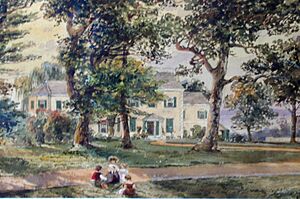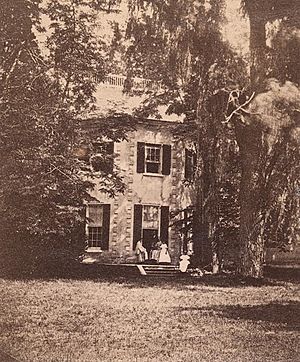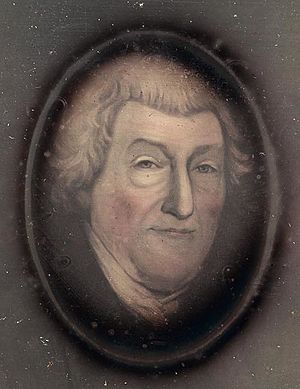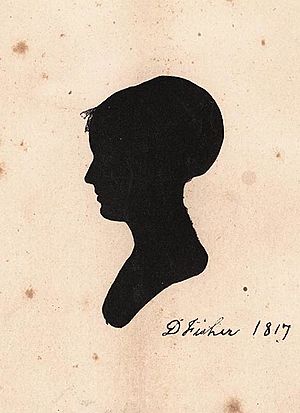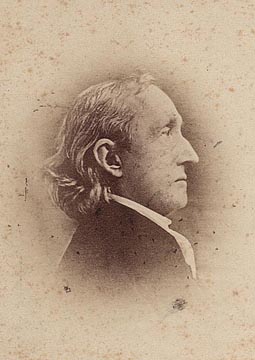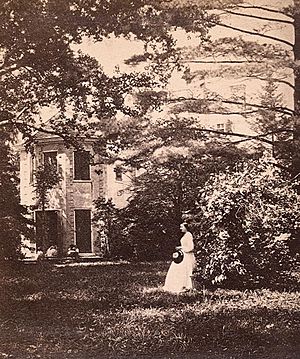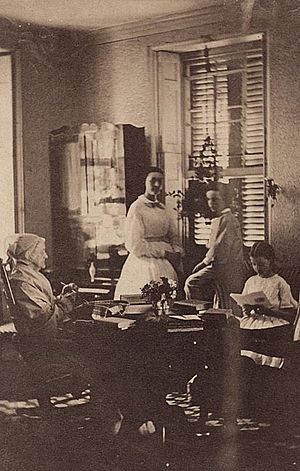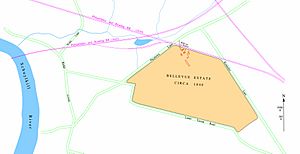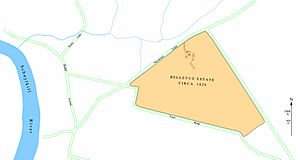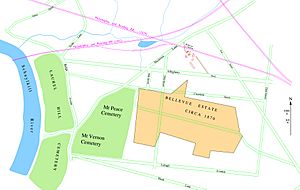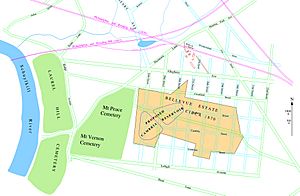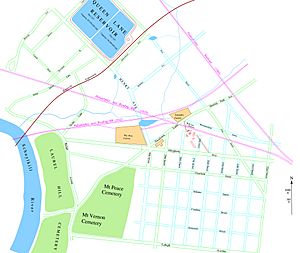Bellevue Mansion facts for kids
Bellevue Mansion was a large, old country house located in North Philadelphia. Today, the spot where it once stood is a park called Etting Square, found between North Marston and North Etting Streets, close to 29th Street and Allegheny Avenue.
Contents
A Family Home for Over 60 Years
In 1802, a Philadelphia merchant named Charles Wharton (who lived from 1743 to 1838) bought Bellevue. It was a big country estate, about 3 miles (5 km) northwest of Philadelphia, near the higher ground of Germantown. Charles Wharton was the grandfather of a famous industrialist named Joseph Wharton.
The Bellevue estate stayed in the Wharton family for more than 60 years. In 1834, Charles Wharton gave the estate to his son, William Wharton (1790–1856). William and his wife, Deborah Fisher Wharton, spent their summers there for twenty years, raising their children.
Life at Bellevue Estate
Bellevue was a working farm that covered about 106 acres (0.43 km²). It had rolling hills, a main house, a barn, sheds, vegetable gardens, fruit orchards, fields, and farm animals. The main house looked out over a small valley and a stream that flowed into the Schuylkill River. Big willows, sycamores, and oak trees surrounded the house and the land. Servants, many of whom were Irish, helped with the house, while hired workers took care of the fields and animals. The estate was surrounded by woods and the homes of other wealthy Philadelphians.
The Bellevue Mansion itself was large and made of stone. It had two stories, a basement, and a special flat area on the roof called a widow's walk. The house was first built by an Englishman who loved to dance, so it had a big ballroom. The Wharton family used this ballroom as a game room. They often visited Bellevue and entertained many guests, both young and old. A road called Nicetown Lane ran next to the nearby stream, leading about half a mile down to the Schuylkill River.
William and Deborah Wharton were very involved in their Quaker Meeting (a type of religious gathering). From 1825 to 1840, they relied on Bellevue and its housemistress to keep their children busy during the summer. Joseph Wharton, his brother Charles, and their other siblings often walked down Nicetown Lane to the Schuylkill River to cool off in the summer heat.
Changes and Challenges for Bellevue
Starting in the 1840s, Bellevue faced threats from new developments in the area.
The Arrival of Railroads
In 1839, the Reading Railroad built its main train line from Philadelphia to Norristown and then north to Reading. This train line ran very close, about 30 yards (27 meters), from the north side of the mansion. The land around Bellevue, between Germantown and the city limits of Philadelphia (which is now North Philadelphia), was mostly undeveloped. However, between 1850 and 1880, business people started buying up many old estates for factories and new housing areas.
For the younger generation, like Joseph Wharton and his siblings, railroads seemed like progress. They made travel faster and helped the region's economy grow. There was even a "Bellevue" train station within a short walk of the mansion, which was very convenient. However, these trains also carried huge loads of coal, thundering past the house at all hours. The constant noise was annoying for guests staying at Bellevue. Even though it was still a beautiful estate, its use as a quiet escape from city life became limited.
Philadelphia's Growth and Water Problems
In 1854, Philadelphia grew its borders to include the surrounding towns. After the American Civil War, the city's population grew to hundreds of thousands of people. By 1870, with the Centennial Exposition coming up, Philadelphia was changing quickly.
The city faced a serious water problem. It needed more water, but there was no good way to clean it, and the Delaware and Schuylkill rivers were very polluted. Philadelphia had one of the highest rates of typhoid fever in the country, so most wealthy families drank bottled spring water.
Threat of the Cambria Reservoir
Even though the railroads had threatened Bellevue since the 1840s, a new, more direct threat appeared in the 1870s. The City of Philadelphia planned to build a large reservoir called the Cambria Reservoir to hold potable water (drinking water). To do this, the city decided to take over the entire Bellevue estate, which was then owned by Joseph Wharton and his siblings, along with several other nearby estates that had become part of the city. The Wharton siblings were upset and frustrated because it seemed they had no way to stop the city from choosing their land for the reservoir.
Joseph Wharton thought he had a solution to Philadelphia's water problems. In the 1870s, he started buying land in southern New Jersey. Eventually, he owned about 150 square miles (388 km²) in the Pinelands. This area had an aquifer (an underground layer of water) that was refilled by several rivers and lakes. The water from the Pinelands was quite clean, and he planned to sell it to Philadelphia. Wharton suggested that a city-controlled company could build the necessary water mains and pumps, paid for by people buying stocks and bonds. However, there was opposition to his plan from others in Philadelphia and New Jersey. Eventually, a law was passed in New Jersey that stopped the export of water.
The End of Bellevue Mansion
The City of Philadelphia did take over the Bellevue estate. However, the planned Cambria Reservoir was never built. This was due to local politics and also because by 1890, water could be purified by filtration, meaning an extra reservoir wasn't needed anymore.
Instead, most of the Bellevue estate was sold to developers. The mansion itself was not kept up and was boarded up. For several decades, the city water department used it to store pipes and other equipment. Finally, the mansion was torn down to make way for new housing for the growing industries in North Philadelphia.
Today, the location of Bellevue Mansion is Etting Square, a small park and playground. It is located between North Marston and North Etting Streets, just north of Allegheny Avenue in North Philadelphia.


